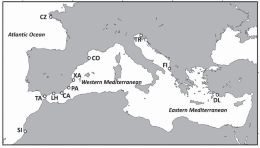The sea urchin Paracentrotus lividus, an eatable species of great commercial interest found in the Mediterranean and North-East Atlantic, is more vulnerable than it was believed so far.

This is stated in a study by the University of Barcelona, the Spanish National Research Council (CSIC) and the University of Tromsø (Norway) on the genetic distribution of populations of this species, led by the experts Marta Pasqual, from the Faculty of Biology and the Biodiversity Research Institute (IRBio) of the University of Barcelona, and Xavier Turon, research lecturer at CSIC and the Blanes Center for Advanced Studies (CEAB-CSIC), the study was recently published in the journal Diversity and Distributions.
This is a genetic study on the population of sea urchins analyses the population structure and its connectivity as a result from their ability to spread. Scientists analysed about two-hundred and fifty models of Paracentrotus lividus from eleven marine areas, going from the French Atlantic coast to the Adriatic Sea heading east.
Researcher Xavier Turon (CEAB-CSIC) notes that “adult sea urchin barely move” and that it actually happens before adulthood, since “when they are larvae, they swim in plankton and are drawn by marine currents. We thought they could easily spread, since they have a long life as larvae, which lasts for weeks”.
What the study reveals is that “this spread is not as we thought it was –says Turon- and geographical barriers such as the Strait of Gibraltar limit the connectivity of populations. The exchange of sea urchin larvae between different areas is more limited than what we thought”.
Another shocking result is that the selection at a local level is having an impact genetically on the different populations of urchins. “We found differenced alleles among populations”, note researchers Marta Pascual and Carles Carreras (UB-IRBio). “When we analysed the genetic sequencing in which these differences appeared, we saw there are genes that code processes related to temperature and salinity”. There is a strong pressure of selection related to temperature in the Mediterranean, which can have important consequences regarding global warming.
The study reveals there is a progressive adaptation to salinity and temperature from west to east, and that the largest genetic differences are seen in populations in the Atlantic and the Mediterranean. In the latter, the populations of western Mediterranean areas are also differentiated from the eastern Mediterranean ones.
Despite being the target of fishing, this species is very abundant in the Catalan coasts, since the fishing pressure removed many of its predators (mainly fish). Urchins are herbivorous and eat submarine plants. With no predators, the population can grow excessively and can end with many submarine forests.